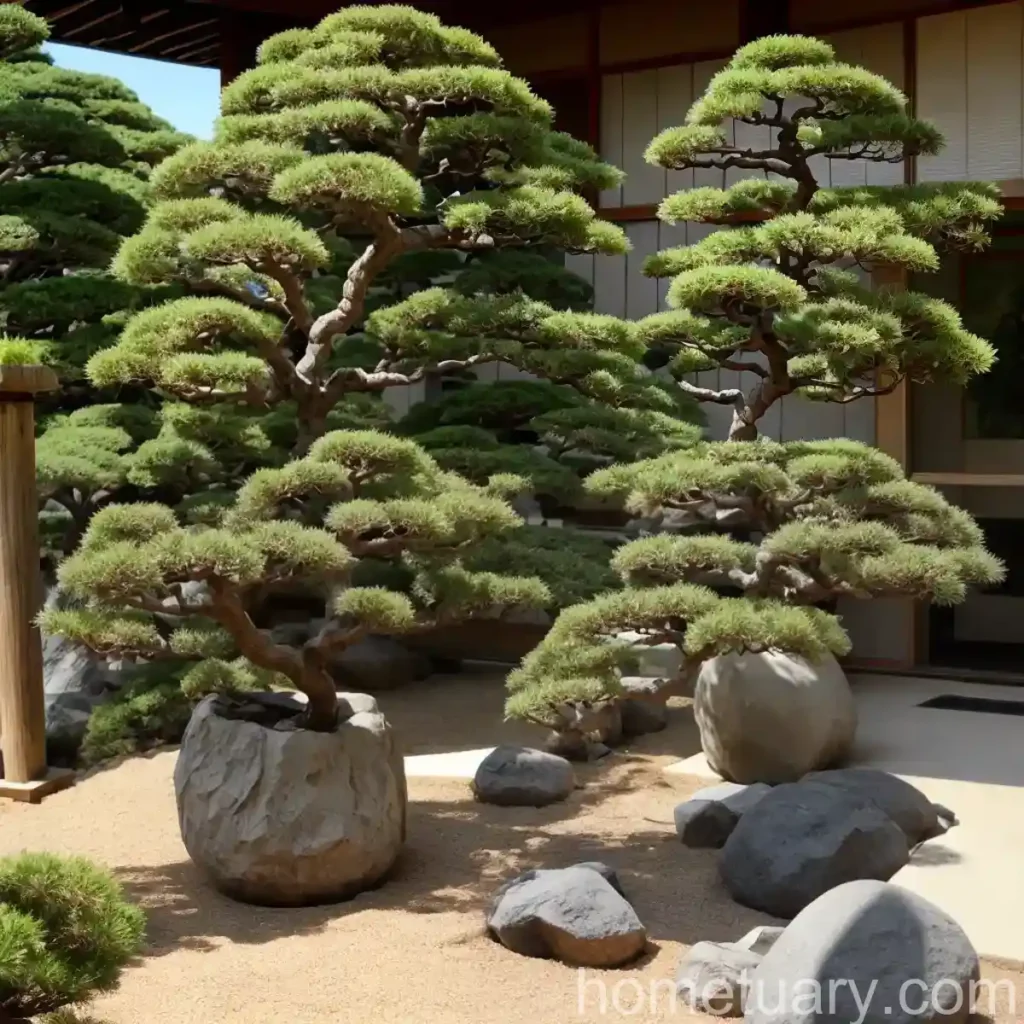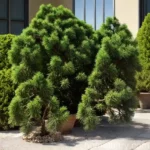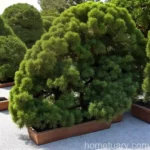Japanese Garden Juniper (Juniperus procumbens): A Comprehensive Guide
Welcome to our comprehensive guide to the Japanese garden juniper (Juniperus procumbens). In this article, we will delve deep into the world of this beautiful and versatile plant. From its cultural significance to its care requirements and landscape design opportunities, we will cover everything you need to know about this fascinating plant species.
What is the Japanese Garden Juniper?
The Japanese garden juniper, scientifically known as Juniperus procumbens, is an evergreen plant native to Japan. This species is a low-growing, spreading shrub that belongs to the cypress family, Cupressaceae. It is revered for its ornamental value and is widely utilized in various landscapes, including Japanese gardens, rock gardens, and bonsai cultivation.
Key Takeaways – Japanese Garden Juniper (Juniperus procumbens)
Before we delve into the details of caring for the Japanese garden juniper, let’s explore the key takeaways that we will cover in this comprehensive guide:
- Culture
- Uses
- Water
- Sunlight
- Fertilizer
- Soil
- Pruning
- Propagation
- Container Popularity
- Common Diseases
- Disease Diagnosis
- Common Pests
- Botanist’s Tips
- Fun Facts
- Links to External Resources
Now that we have an overview of the topics we will cover, let’s dive into the world of the Japanese garden juniper and explore its characteristics, care requirements, and more.
Culture of Japanese Garden Juniper
The cultural significance of the Japanese garden juniper extends beyond its botanical traits. In Japan, this species holds a revered place in traditional gardens, symbolizing longevity, strength, and the ability to withstand harsh conditions. Let’s explore the cultural aspects associated with this remarkable plant:
- Symbolism: The Japanese garden juniper is often associated with resilience and enduring strength in Japanese culture. Its ability to thrive in rocky, harsh environments has made it a symbol of perseverance and longevity.
- Bonsai Tradition: Juniperus procumbens has been a popular choice for bonsai cultivation for centuries. In Japanese bonsai art, the age and rugged beauty of the Japanese garden juniper are highly esteemed, adding a sense of tranquility and agelessness to the miniature landscapes.
- Garden Design: In traditional Japanese gardens, the Japanese garden juniper is strategically incorporated to create visually striking compositions. Its sprawling and cascading growth habit adds a sense of tranquility and natural harmony to the garden space.
Uses of Japanese Garden Juniper
The Japanese garden juniper offers a wide array of uses, ranging from ornamental landscaping to its incorporation in traditional medicine. Understanding its diverse applications is crucial in appreciating the significance of this remarkable plant:
- Ornamental Landscaping: Juniperus procumbens is extensively used in landscaping to create visually appealing ground covers, especially in rock gardens and slopes. Its low-growing and spreading nature makes it an excellent choice for adding texture and depth to the landscape.
- Bonsai Cultivation: This species is highly prized in the art of bonsai cultivation. Its adaptability to various pruning techniques and its naturally picturesque appearance make it an ideal candidate for creating bonsai masterpieces.
- Medicinal Purposes: In traditional Japanese medicine, the Japanese garden juniper has been utilized for its purported medicinal properties. From treating digestive issues to serving as a diuretic, various parts of the plant have been historically used for their potential health benefits.
Japanese Garden Juniper Care
Proper care for the Japanese garden juniper is essential to ensure its health, longevity, and ornamental appeal. Let’s explore the key aspects of caring for Juniperus procumbens, from its water and sunlight requirements to soil preferences and propagation methods.
Water
Effective management of watering is critical for maintaining the health and vigor of the Japanese garden juniper. Understanding its water requirements can help prevent issues such as root rot and dehydration.
Japanese Garden Juniper Water Requirements
- Established Plants: Once established, Japanese garden junipers exhibit moderate drought tolerance. Water deeply but infrequently to encourage deep root growth. It is advisable to allow the top inch of the soil to dry out between watering to prevent waterlogging.
- Young Plants: Newly planted specimens require more frequent watering to aid in root establishment. Monitor the moisture level of the soil regularly and adjust the watering frequency based on the plant’s needs and the prevailing weather conditions.
Sunlight
Proper sunlight exposure is crucial for the healthy growth and development of the Japanese garden juniper. Understanding its sunlight requirements can help in selecting optimal planting locations and ensuring its overall vitality.
Juniperus procumbens Sun Exposure
- Full Sun: Japanese garden junipers thrive in full sun to partial shade. When planted in full sun, they tend to exhibit their most robust growth and maintain their characteristic dense foliage.
- Partial Shade: While the plant can tolerate partial shade, it may result in reduced foliage density and slower growth. In regions with intense summer heat, providing some afternoon shade can help protect the plant from excessive stress.
Fertilizer
Applying the right type and amount of fertilizer can promote healthy growth and vibrant foliage in Japanese garden junipers. Let’s explore the best practices for fertilizing Juniperus procumbens.
Juniperus procumbens Feeding Requirements
- Nutrient Needs: Japanese garden junipers have relatively low nutrient requirements. A balanced, slow-release fertilizer formulated for acid-loving plants can be applied in early spring to provide the necessary macronutrients.
- Application Frequency: Fertilize once a year in late winter or early spring before new growth begins. Avoid overfertilization, as excessive nutrient levels can have detrimental effects on the plant’s health.
Soil
Understanding the soil preferences of the Japanese garden juniper is essential for creating optimal growing conditions. Proper soil management can contribute to the plant’s overall vigor and resilience.
Juniperus procumbens Soil Preferences
- Well-Drained Soil: Japanese garden junipers thrive in well-draining, slightly acidic soils with a pH range between 5.5 and 6.5. Compacted or waterlogged soils should be avoided to prevent root suffocation and potential disease issues.
- Soil Amendments: Incorporating organic matter such as compost or peat moss during planting can improve soil structure and fertility. Additionally, mulching with organic materials can help conserve soil moisture and regulate soil temperature.
Pruning
Regular pruning is essential for maintaining the desired shape, size, and health of the Japanese garden juniper. Proper pruning techniques can enhance its aesthetic appeal and longevity.
Juniperus procumbens Pruning Tips
- Timing: Pruning is best performed in late winter to early spring before the start of the growing season. Avoid pruning in late summer or fall, as the plant may not have sufficient time to recover before winter.
- Techniques: Use sharp, clean pruning shears to remove dead, diseased, or overgrown branches. When shaping the plant, trim selectively to maintain its natural form and avoid excessive pruning, which may compromise its health.
Propagation of Japanese Garden Juniper
The propagation of Japanese garden junipers enables gardeners to expand their collection and share the beauty of this species with others. Let’s explore the various methods of propagating Juniperus procumbens.
Juniperus procumbens Propagation Methods
- Seed Propagation: While feasible, propagation from seed is a relatively slow process and may result in genetic variability. Sow seeds in well-draining, seed-starting mix and ensure consistent moisture until germination occurs.
- Stem Cuttings: Propagation from semi-hardwood stem cuttings in late summer or early fall offers a more reliable method. Dip the cut ends in rooting hormone and plant in a well-draining medium, maintaining moderate humidity until roots form.
- Layering: Air-layering can also be employed to propagate Japanese garden junipers. Girdle a lower branch, apply rooting hormone to the wounded area, wrap with moist sphagnum moss, and cover with plastic to encourage root development.
Container Popularity
The Japanese garden juniper’s adaptability to container gardening has made it a popular choice for creating captivating displays in limited spaces. Let’s explore the considerations and best practices for growing Juniperus procumbens in containers.
Juniperus procumbens Container Gardening
- Container Selection: Choose a well-draining container of sufficient size to accommodate the plant’s root system and allow for adequate airflow. Unglazed terra cotta or breathable plastic pots are excellent choices.
- Potting Mix: Utilize a well-draining potting mix formulated for container cultivation. Incorporate perlite or coarse sand to improve aeration and drainage.
- Watering and Maintenance: Container-grown Japanese garden junipers require more frequent watering than those planted in the ground. Monitor the moisture level of the soil and adjust watering frequency based on the plant’s needs and climate conditions.
Common Diseases of Japanese Garden Juniper
While generally resilient, Japanese garden junipers are susceptible to certain diseases that can affect their health and vigor. Understanding these diseases and their preventive measures is critical for maintaining the plant’s well-being.
Disease Diagnosis
Identifying common diseases that affect Juniperus procumbens is essential for implementing timely and effective interventions. Let’s explore some of the prevalent diseases and their diagnostic features:
- Diplodia Tip Blight: Symptoms include browning and dieback of branch tips, often accompanied by the presence of black, pinhead-sized fungal fruiting bodies (pycnidia) on affected tissues.
- Phomopsis Tip Blight: Infected branches exhibit browning and dieback, with small, black fungal fruiting structures (pycnidia) typically present on the lesions.
- Cedar-apple Rust: This fungal disease manifests as yellow-orange spots on the foliage, often accompanied by fruiting structures on the affected areas.
Disease Prevention
Implementing preventive measures can reduce the risk of disease development and promote the overall health of Japanese garden junipers. Here are some strategies for disease prevention:
- Cultural Practices: Maintain proper spacing between plants to encourage good air circulation and reduce humidity around the foliage. Avoid overhead watering to minimize moisture on the foliage, which can create favorable conditions for disease development.
- Sanitation: Promptly remove and dispose of any diseased plant material to prevent the spread of pathogens. Regularly sanitize pruning tools with a diluted bleach solution to prevent cross-contamination between plants.
Common Pests Affecting Japanese Garden Juniper
In addition to diseases, Japanese garden junipers can also fall victim to various pests that can impact their growth and aesthetic appeal. Understanding these pests and their control measures is crucial for maintaining plant health.
Juniperus procumbens Pest Control
- Spider Mites: These tiny arachnids can cause stippling and webbing on the foliage. Mitigate their populations by periodically rinsing the foliage with a strong jet of water and introducing predatory mites as a natural control method.
- Juniper Scale: Scale insects can infest the foliage and stems, leading to yellowing and weakening of the plant. Control scale populations by employing horticultural oil sprays during the plant’s dormant period to suffocate and eliminate the insects.
Botanist’s Tips
To help you foster a thriving and visually appealing Japanese garden juniper, here are some expert tips from botanists and horticultural professionals:
- Selecting Companion Plants: When designing a landscape with Japanese garden junipers, consider pairing them with plants that share similar cultural requirements and complement their foliage colors and growth habits. Suitable companions include low-growing conifers, ornamental grasses, and perennials with contrasting textures.
- Winter Protection: In regions with harsh winter conditions, consider providing some protection to Japanese garden junipers to minimize potential damage from frost and cold winds. Erecting windbreaks or applying an anti-desiccant spray can help shield the plants from winter stress.
- Soil pH Management: Regularly monitor and adjust the soil pH to ensure it remains within the preferred range for Japanese garden junipers. Application of elemental sulfur or acidic fertilizers can help lower the pH of alkaline soils, creating more favorable growing conditions.
Fun Facts About Japanese Garden Juniper
To further deepen your appreciation for the Japanese garden juniper, here are some intriguing and delightful fun facts about Juniperus procumbens:
- Longevity: Some specimens of Japanese garden juniper are known to live over 100 years, showcasing their enduring vigor and resilience.
- Wild Habitat: In its native range in Japan, the Japanese garden juniper can be found in diverse habitats, from coastal cliffs to mountain slopes, highlighting its adaptability to various environmental conditions.
- Aromatic Foliage: When crushed or bruised, the foliage of Japanese garden junipers releases a pleasant, resinous aroma, adding to their sensory appeal.
Links to External Resources
For further information and resources on Japanese garden juniper care, landscape design, and related topics, we recommend exploring the following external links:
- The American Conifer Society: Juniperus procumbens Species Profile
- Royal Horticultural Society: Growing Junipers
- University of California Statewide Integrated Pest Management Program: Juniper Pest Management Guidelines
Thank you for joining us on this exploration of the captivating world of the Japanese garden juniper. We hope this comprehensive guide has provided valuable insights and practical tips for cultivating and appreciating this remarkable plant species. By understanding its cultural significance, care requirements, and ecological importance, we can foster a deeper connection with the natural world and create enriching landscapes that showcase the enduring beauty of Juniperus procumbens.















